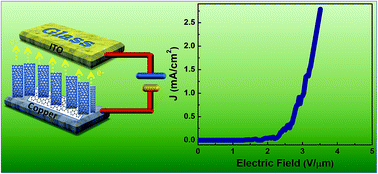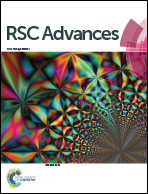Growth of dense CNT on the multilayer graphene film by the microwave plasma enhanced chemical vapor deposition technique and their field emission properties†
Abstract
Catalyst assisted carbon nanotubes (CNTs) were grown on multilayer graphene (MLG) on copper and silicon substrates by the microwave plasma enhanced chemical vapor deposition technique. The transmission of the MLG was found to vary between 82 to 91.8% with the increase of deposition time. Scanning electron microscopy depicted that the MLG film survived at the deposition condition of CNTs with the appearance of the damaged structure due to the plasma. Growth of CNTs was controlled by adjusting the flow rates of methane gas. The density of carbon nanotubes was observed to increase with a higher supply of methane gas. It was observed that the field emission properties were improved with the increased density of CNTs on MLG. The lowest turn-on field was found to be 1.6 V μm−1 accompanied with the highest current density of 2.8 mA cm−2 for the CNTs with the highest density. The findings suggested that the field emission properties can be tuned by changing the density of CNTs.


 Please wait while we load your content...
Please wait while we load your content...